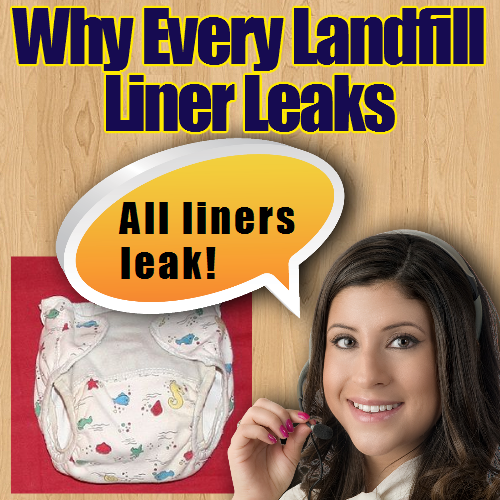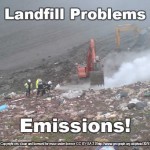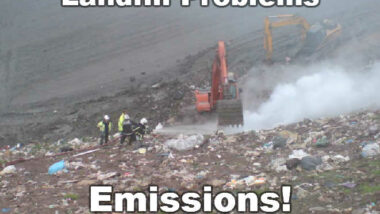
In fact no single landfill ever built will not allow the passage of some water through the base, even within the initial design life of the lining. In engineering terms the rate of movement through the liner will be exceedingly small per unit area, and can be calculated by using the D’Arcy Equation. Nevertheless, when the large area of the base is considered, even extremely low permeabilities result in “leakage” rates in the tens of cubic metres per annum for average sized sites, where the lining is perfectly installed, and undamaged.
Although this initially sounds alarming, all landfill designs are based upon groundwater impact assessments (IAs), and it can safely be assumed that the design “leakage “ rate will be far lower that the dilution in the groundwater provided by natural groundwater movement.
Current landfill designs, in the UK, are also carried out also in the full knowledge of research which has shown the typical rates of imperfections which can be expected, and do include suitable allowances. (The IAs are in fact based upon the increased rates of leakage which result from these imperfections.)
Liner Leaks in Context
The use of composite liner systems is still a relatively new practice, and studies have indicated that many of the early lined landfills lined only with a synthetic flexible membrane, or geomembranes (the commonest being HDPE) are leaking.Contact Us for Closed & Active Landfill Remediation Service.
However, it should not be forgotten how rapidly the waste industry has progressed from unlined “so called” dilute-and-disperse landfills to the single geomembrane, and now in most nations composite lining systems are mandatory.
Landfills were not previously lined at all, and have a long history of leakage with resulting environmental impacts to groundwater.
Before lining was introduced in the 1980 impacts on surface water, the unsaturated zone, and the atmosphere per tonne disposed were far worse.
Adoption of Landfill Leakage Prevention
In the United States & Europe, prior to the 1980’s, landfills did not have specific construction requirements aimed at preventing leakage. In the early 1990’s, to reduce existing environmental impacts and to prevent future impacts, the United States Environmental Protection Agency (US EPA) called for the closure of older, unlined landfills and began adopting minimum standards for new landfill design.
A similar process was underway in the UK and Europe from the early to mid-1980s. In the UK the relevant guidance was contained in the Waste Management Papers (now withdrawn), published by the DoE (HMSO). Waste Management Paper 26b being the most important.
A primary design requirement of the new 1980s-1990s standards was the recognition that a composite landfill liner system would be essential for all future landfills.
Composite landfill liners, while both being introduced for the same reason on both sides of the Atlantic, vary in their engineering detail between Europe and the US.
Composite Landfill Liner Requirements
The US requirement is that the minimum composite lining system combines:
- an upper liner of a synthetic flexible membrane;
- and a lower layer of soil at least 0.6 metres-thick with a hydraulic conductivity of no greater than 1 x 10-7 cm/sec (1 x 10-9 m/sec) (or an alternative combination that provides equivalent hydraulic conductivity). The standards also require landfills to have a leachate collection system designed to maintain the depth of the leachate over the liner less than 30 cm.
Most US lining systems incorporate a double synthetic lining with leak detection placed between the upper and lower layers. This practise has seldom if ever been adopted in Europe, where rather than investment in the detection layer, it was decided that the equivalent cost would be better invested in an increased depth of the soil (clay) layer.
In the EU the lower liner of soil material (clay) must (generally) be a minimum 1 metre thick.
Several years of environmental monitoring at newer landfills designed and constructed in accordance with US EPA regulations, and to similar requirements elsewhere, has indicated that where landfills to the new standards have leaked, it has generally been as a result of construction errors and/or failed operational procedures.
Landfill Liner Leak Reduction
Construction errors as reduced by the implementation of stringent Construction Quality Assurance (CQA) procedures, but experience has shown that these can only reduce imperfections in synthetic (HDPE) membranes as installed to a low level. Some leaks will still be present.
To find, and then repair HDPE landfill liner leaks (punctures) specialist Geophysical Leak Detection Contracting Companies have evolved which offer to carry out a survey after the leachate drainage layer has been installed, and before the first waste is placed in each landfill cell. This surveys can pinpoint leaks found with great accuracy enabling each to be patched before the first waste is placed.
Operational procedures are being tightened progressively, and are particularly tightly controlled in the UK nowadays, by the environmental regulators (EA, SEPA, and EHS (NI). It is recognised that the emplacement of the first 1 metre of waste above the landfill lining must be carefully undertaken in such a manner which avoids physical damage either by vehicles tracking too close to the liner and imposing excessive localised direct loads, or by the waste containing large items which may induce excessive point loads or punching forces.
Contact us by filling in the form here if you need any one, or more, of the following:
- recommended CQA procedures for composite landfill lining installations;
- information on Geophysical Leak Detection contractors;
- information on withdrawn Waste Management Papers.
Unfashionable Talk About Landfills
Get ready for unfashionable talk about landfills! Let’s talk rubbish—literally. You might not think about landfills much unless the smell drifts your way on a windy day or you’re tossing out the garbage. But these dumping grounds are more than just piles of junk; they’re a snapshot of our consumer habits and a challenge we need to tackle. Landfill […]
What is a Landfill?
So, you ask; “What is a Landfill?” Stay and read-on here and we will tell you! A landfill is an engineered pit, in which layers of solid waste are filled, compacted and covered for final disposal. According to UNEP (2002), a basic landfill is a pit with a protected bottom (to prevent contamination of groundwater) […]
Landfill Environmental Problems – Emissions
MSW Landfills are very unpopular due to the many environmental problems which have been attributed to landfills. In Europe there is massive investment underway to substantially reduce reliance on landfills. In many areas worldwide landfill space is running out, due to public hostility arising from public perception of landfills and environmental problems, and a crisis […]









The world needs to be told. Other research also agrees with this.
In the absence of holes, the leakage of water or leachate through a typical 1.5 mm HDPE GM used in landfill applications is negligible. However, experience has shown that it is extremely difficult to ensure no holes exist in practical situations.
Holes may arise from: (i) manufacturing defects, (ii) handling of the GM rolls, (iii) on-site placement and seaming, (iv) the placement of drainage gravel over the liner system, (v) traffic over the liner or the overlying protection layer, (vi) placement of the waste in a landfill or cleaning of residue from a leachate lagoon, and (vii) stress cracking as the GM ages. https://www.nrcresearchpress.com/doi/full/10.1139/t11-092#.XOcpXIhKiUk
Thank you. The info and comments were helpful. Haralson County Landfill (proposed 300 acres with total 2000 including buffer). M.O.: Developer comes in, resells and toxins brought in. Was told by those who actually work in landfills, some of the atrocities, also engineers to the water. The world needs to recycle more and it be made cost effective versus just dumping in liners until they break.